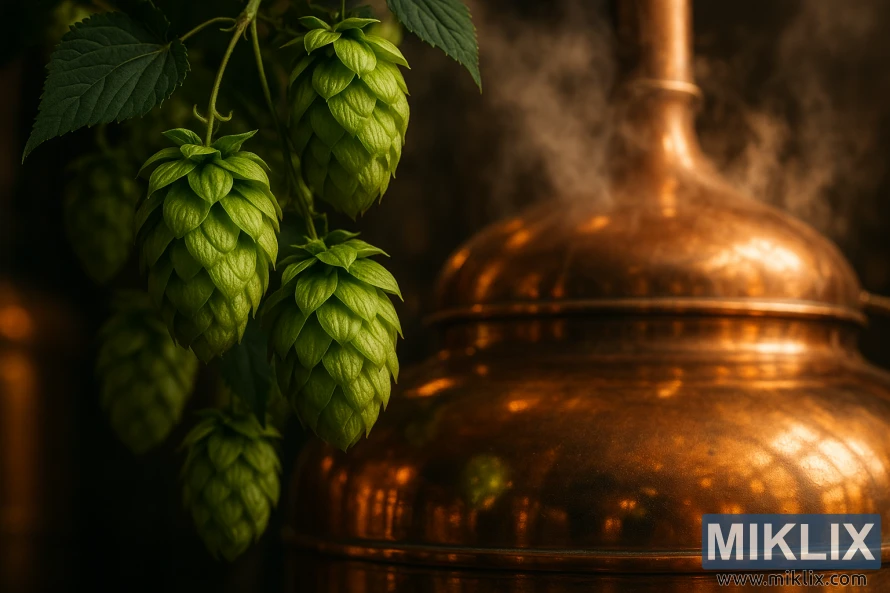Image: Topaz Hops and Brew Kettle
Published: August 6, 2025 at 5:00:04 PM UTC
Last updated: September 27, 2025 at 9:07:36 AM UTC
Topaz hops cascade in front of a steaming copper brew kettle under amber light, highlighting their lupulin detail and role in artisanal beer brewing.
In this evocative still-life composition, the viewer is invited into the intimate heart of the brewing process, where nature’s bounty and human craftsmanship meet in harmony. Dominating the foreground, a cluster of freshly harvested Topaz hop cones hangs with vibrant energy, their tightly layered bracts rendered in sharp detail. Each cone, with its subtle gradients of green and its papery, textured surface, seems to glisten with vitality, as though the essential oils and lupulin glands within are poised to burst forth with their aromatic complexity. They embody not only the agricultural cycle of planting, tending, and harvesting but also the transformative potential they hold once introduced into the kettle just beyond them. The soft, diffused lighting captures every nuance of their form, elevating these modest cones into something iconic, a symbol of both tradition and innovation in brewing.
Behind them, rising like a sentinel of tradition, the copper brew kettle gleams warmly in the amber-toned light. Its polished surface reflects subtle hints of the green cones suspended above it, creating a dialogue between raw ingredient and brewing vessel, between what is and what is to become. Wisps of steam curl upward from its domed lid, softening the hard lines of the metal and imbuing the scene with an atmosphere of transformation. This is a vessel steeped in history, its copper walls recalling centuries of brewing practices, when such kettles were the centerpiece of every brewhouse. The metal’s patina, slightly dulled in places, speaks to countless brews past, each one a chapter in the unbroken chain of human ingenuity applied to a natural process. Here, in this moment, it is alive once more, promising to transform water, malt, yeast, and hops into a beverage greater than the sum of its parts.
The lighting throughout the scene feels carefully orchestrated, falling in warm, golden tones that emphasize the textures and colors while preserving a sense of intimacy. Shadows dance across the kettle’s curves and the cones’ overlapping bracts, accentuating depth and inviting the eye to linger on details. The steam rising from the kettle appears almost ethereal, a visible manifestation of energy, heat, and transformation, as if the air itself is infused with the floral, resinous fragrance of the hops. It creates a sensory bridge, allowing the viewer to almost smell the earthy, spicy, and fruity notes for which Topaz hops are prized, notes that will ultimately imbue the beer with its unique character.
This interplay of natural ingredient and crafted vessel serves as more than mere visual contrast—it is a narrative of brewing itself. The hops, freshly picked and still redolent of the soil and sun, represent the raw artistry of agriculture, while the kettle embodies the structured, scientific side of brewing. Between the two lies a tension that has always defined beer-making: the balance of nature’s unpredictability with human control and precision. The Topaz variety, known for its bold flavors that range from tropical fruit and lychee to earthy, resinous undertones, stands at the center of this balance, capable of shaping a beer’s aroma and taste profile in profound ways.
The overall atmosphere is one of quiet reverence. The soft light, the slow curling steam, the vivid freshness of the hops, and the enduring solidity of the copper kettle all converge to remind us that brewing is not merely a mechanical process but a form of alchemy. Each detail suggests patience, tradition, and artistry: the farmer’s careful cultivation, the brewer’s watchful eye, the timeless rhythm of boiling, steeping, and fermenting. Within this single frame lies the story of beer’s creation, told not with words but through the glow of copper, the freshness of green, and the haze of steam rising into the air.
Ultimately, the image conveys both intimacy and grandeur. It invites the viewer to step closer, to run a hand over the textured bracts of the hop cone or to feel the warmth radiating from the kettle’s surface. At the same time, it gestures toward something larger: the centuries-old tradition of brewing and the way a simple cone of hops can influence not just a beer but entire cultures and histories. The Topaz hops take center stage here not simply as an ingredient, but as a muse, their presence reminding us of the remarkable journey from field to kettle, from kettle to glass.
The image is related to: Hops in Beer Brewing: Topaz

